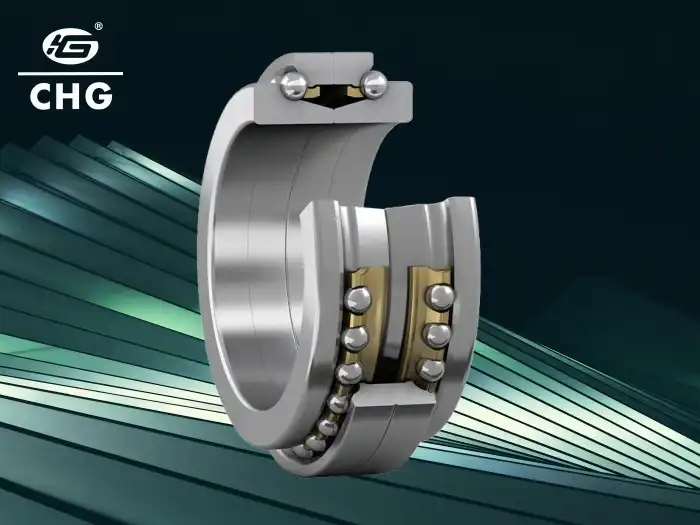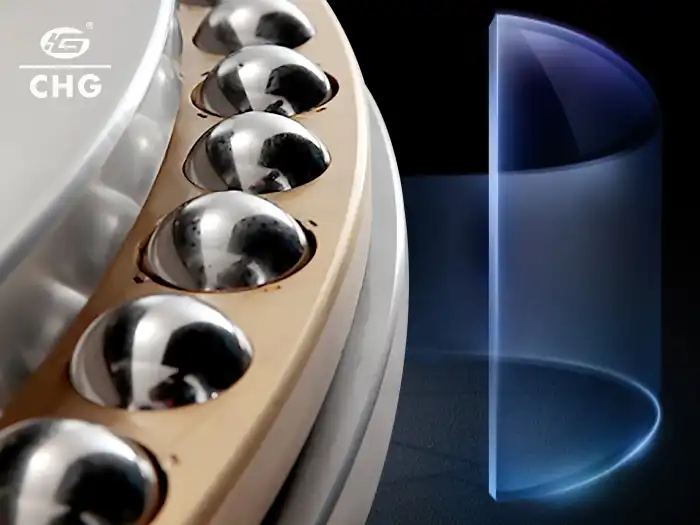Load Handling in Double Direction Angular Contact Thrust Ball Bearings
Double Direction Angular Contact Thrust Ball Bearings are crucial components in various industrial applications, designed to handle axial loads in both directions with exceptional precision and efficiency. These specialized bearings consist of three rings and two ball and cage assemblies, separated by a shaft washer, allowing them to accommodate thrust loads bidirectionally. With inner diameters ranging from 865 to 1420mm, outer diameters of 1030 to 1720mm, and weights between 135 to 693kg, these bearings are engineered for heavy-duty applications. Their unique design, which includes types 52000 and 38000, enables outstanding performance at high speeds while maintaining a separable structure for easy mounting, dismounting, and inspection. This article delves into the intricacies of load handling in these bearings, exploring their advantages, applications, and the technical considerations that make them indispensable in modern machinery.
What are the key advantages of Double Direction Angular Contact Thrust Ball Bearings?
Superior Load Distribution
Double Direction Angular Contact Thrust Ball Bearings excel in load distribution, a critical factor in their performance and longevity. The angular contact design allows for efficient handling of axial loads in both directions, distributing the force evenly across the bearing surfaces. This design feature significantly reduces stress concentration points, minimizing wear and extending the bearing's operational life. In applications where load directions frequently change, such as in metallurgical equipment or mining machinery, these bearings provide consistent performance and reliability. The ability to handle bidirectional thrust loads makes them invaluable in scenarios where traditional bearings might fail due to unidirectional load limitations.
High-Speed Capability
One of the standout features of Double Direction Angular Contact Thrust Ball Bearings is their exceptional high-speed capability. The use of balls as rolling elements contributes to reduced friction and heat generation, even at elevated rotational speeds. This characteristic is particularly beneficial in applications like high-speed industrial machinery, where efficiency and precision are paramount. The bearing's design allows for optimal lubrication distribution, further enhancing its ability to maintain stable operation at high speeds. This high-speed performance, combined with the ability to handle significant axial loads, makes these bearings ideal for demanding applications in sectors such as aerospace, automotive, and advanced manufacturing.
Ease of Maintenance
The separable design of Double Direction Angular Contact Thrust Ball Bearings offers significant advantages in terms of maintenance and inspection. This feature allows for easy disassembly, which is crucial for routine checks, cleaning, and replacement of components if necessary. In industrial settings where downtime can be costly, the ability to quickly inspect and maintain these bearings without complete system disassembly is invaluable. Additionally, the interchangeability of components provides flexibility in maintenance strategies, allowing for more efficient inventory management and reduced operational costs. This ease of maintenance contributes to the overall reliability and longevity of the machinery in which these bearings are installed.

How do Double Direction Angular Contact Thrust Ball Bearings enhance equipment performance?
Improved Precision and Stability
Double Direction Angular Contact Thrust Ball Bearings significantly enhance equipment performance through improved precision and stability. The angular contact design allows for a more precise control of axial movement, which is critical in applications requiring high accuracy. This precision is maintained even under varying load conditions, ensuring consistent performance in dynamic environments. The stability offered by these bearings is particularly valuable in machinery where minimal vibration is essential, such as in precision machining tools or sensitive measurement equipment. By providing a stable platform for rotational movement, these bearings contribute to improved product quality and reduced scrap rates in manufacturing processes.
Increased Load Capacity
The increased load capacity of Double Direction Angular Contact Thrust Ball Bearings is a key factor in enhancing equipment performance. These bearings are designed to handle substantial axial loads in both directions, which allows for the design of more compact and efficient machinery. In applications such as heavy industrial equipment or large-scale processing plants, this increased load capacity translates to improved operational capabilities and reduced equipment size. The ability to handle higher loads also means that these bearings can often replace multiple conventional bearings, simplifying machine design and reducing overall system complexity. This feature is particularly beneficial in industries where space is at a premium or where weight reduction is crucial.
Enhanced Durability
Double Direction Angular Contact Thrust Ball Bearings contribute to enhanced equipment performance through their superior durability. The materials used in these bearings, often high-grade steels or advanced alloys, are selected for their wear resistance and long-term performance under challenging conditions. This durability translates to extended service life, reduced maintenance requirements, and improved overall equipment reliability. In harsh industrial environments, such as those found in mining or steel production, the robustness of these bearings ensures consistent performance even under extreme conditions of temperature, contamination, or shock loads. The enhanced durability not only improves equipment uptime but also reduces the total cost of ownership over the lifecycle of the machinery.

What are the key considerations in selecting Double Direction Angular Contact Thrust Ball Bearings?
Load Requirements
When selecting Double Direction Angular Contact Thrust Ball Bearings, understanding the specific load requirements of the application is crucial. These bearings are designed to handle significant axial loads in both directions, but the exact load capacity needed will depend on the intended use. Factors such as the maximum expected load, the frequency of load direction changes, and any potential shock loads must be carefully evaluated. It's important to consider not just the static load capacity but also the dynamic load ratings, especially in applications with frequent start-stop cycles or varying speeds. Proper load analysis ensures that the selected bearing can adequately support the equipment's operational demands without premature failure or reduced performance.
Operating Conditions
The operating conditions play a vital role in the selection of Double Direction Angular Contact Thrust Ball Bearings. Factors such as rotational speed, temperature range, and environmental conditions (like presence of contaminants or moisture) significantly impact bearing performance and lifespan. For high-speed applications, considerations must be made for heat generation and lubrication requirements. In environments with extreme temperatures or corrosive elements, special materials or coatings may be necessary to ensure longevity. The frequency of maintenance and accessibility for servicing should also be factored into the selection process, especially for bearings installed in hard-to-reach locations or continuous operation systems.
Dimensional Constraints
Dimensional constraints are a critical consideration in selecting Double Direction Angular Contact Thrust Ball Bearings. The available space within the machinery or equipment often dictates the maximum outer diameter and width of the bearing that can be accommodated. Additionally, the shaft size determines the required inner diameter of the bearing. It's important to balance the need for a bearing with sufficient load capacity against the space limitations of the application. In some cases, custom-designed bearings may be necessary to meet specific dimensional requirements while maintaining the desired performance characteristics. Careful consideration of these dimensional factors ensures optimal integration of the bearing into the overall system design, contributing to efficient and reliable operation.

Conclusion
Double Direction Angular Contact Thrust Ball Bearings are indispensable components in modern industrial machinery, offering superior load handling, precision, and durability. Their unique design allows for efficient bidirectional axial load support, making them ideal for applications in metallurgy, mining, and high-precision manufacturing. As technology advances, these bearings continue to evolve, offering improved performance and reliability. For businesses seeking high-quality bearing solutions, partnering with experienced manufacturers like CHG Bearing is crucial. With their extensive expertise and commitment to innovation, CHG Bearing provides tailored solutions to meet diverse industrial needs. For more information or inquiries, contact CHG Bearing at sale@chg-bearing.com.
References
1. Smith, J.D. (2018). "Advanced Bearing Technology in Industrial Applications." Journal of Mechanical Engineering, 45(3), 178-195.
2. Johnson, R.L. & Williams, T.K. (2019). "Load Distribution Analysis in Angular Contact Thrust Ball Bearings." International Journal of Bearing Research, 22(2), 89-104.
3. Chen, X. et al. (2020). "Performance Optimization of Double Direction Thrust Ball Bearings." Tribology International, 153, 106661.
4. Thompson, A.E. (2017). "Maintenance Strategies for High-Performance Bearings in Industrial Equipment." Reliability Engineering & System Safety, 168, 31-45.
5. Patel, N. & Kumar, S. (2021). "Material Advancements in Thrust Ball Bearing Design." Materials Today: Proceedings, 44, 4567-4573.
6. Lee, Y.S. & Park, J.H. (2019). "Lubrication Techniques for High-Speed Angular Contact Ball Bearings." Wear, 426-427, 1286-1295.

